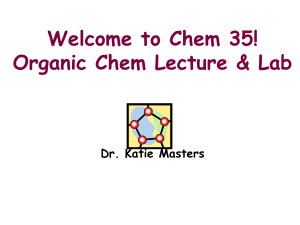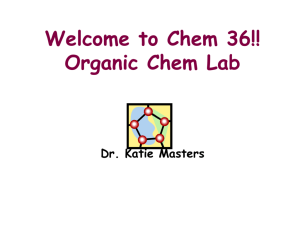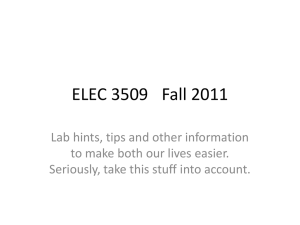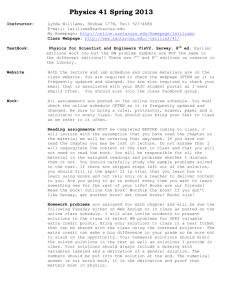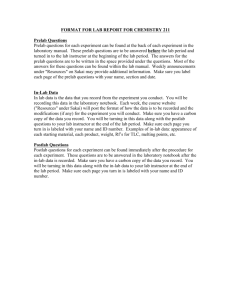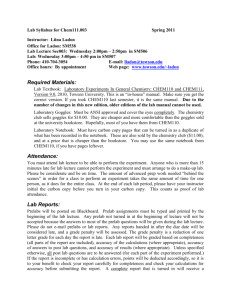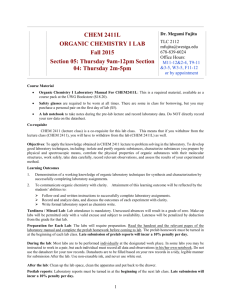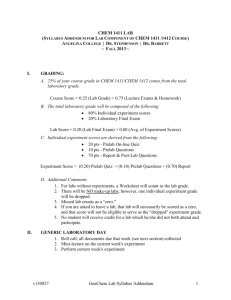PowerPoint Presentation - No Slide Title
advertisement
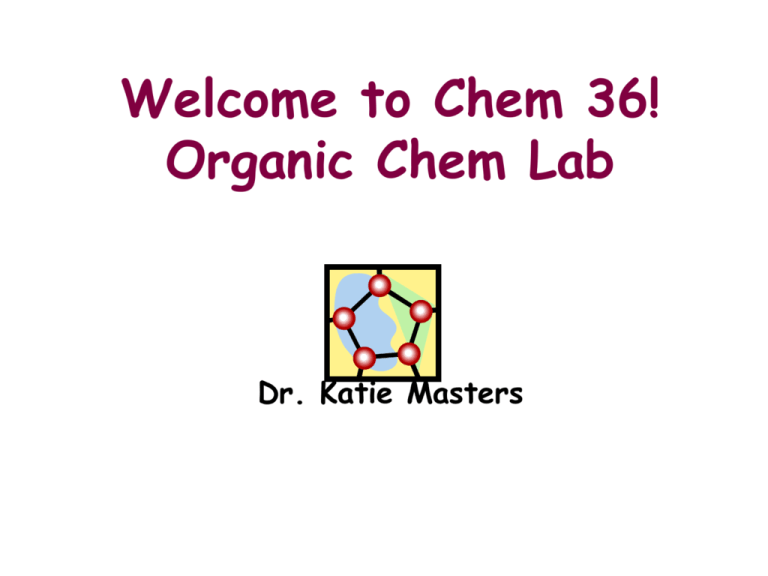
Welcome to Chem 36! Organic Chem Lab Dr. Katie Masters Chem 36 Info Section 1: Section 2: Section 3: M/W at 1:25 to 4:25 pm in 205/215 Whitmore Lab M/W at 1:25 to 4:25 pm in 205/215 Whitmore Lab T/R at 6:30 to 9:30 pm in 205/215 Whitmore Lab Faculty in Charge Dr. Katie Masters Director, Organic Labs 218 Whitmore Lab Phone: 863-3319 kmasters@psu.edu Dr. Jackie Bortiatynski Director, Instrumentation 211D Whitmore Lab Phone: 865-2772 jackie@chem.psu.edu Office Hours Wednesdays, 3 to 5 pm Website http://courses.chem.psu.edu/chem36 Course Materials Lab Guide for Chemistry 36: Introductory Organic Laboratory Minard, Masters, Halmi & Williamson, 2006-2007 Edition, Hayden McNeil Organic Chemistry Laboratory Notebook, 2nd Edition, Hayden McNeil Eye Protection - Eye Protection is required at all times in lab! Organic Lab Equipment Kit Combination or key lock - for next week Lab apron and rubber gloves (optional) Lab Assignments First Half of Semester: Second Half of Semester: 5 Technique Experiments • Recrystallization & Melting Point • Distillation & Boiling Point • Liquid/Liquid Extraction • Thin-Layer Chromatography (TLC) • Column Chromatography 5 Synthetic Experiments Assigned experiments; Download from the course website. Throughout the Semester: Spectral Unknown Experiment Determine an unknown’s structure Assessment: PreLabs (30 pts) and Final Reports (100 pts) For each experiment you run. Ch 10 has no PreLab. 6 Lab Quizzes (50 pts) Final Exam (100 pts) Breakdown of the Chem 36 Points Chapter 1 5 Technique Experiment PreLabs 120 points* 5 Technique Experiment Final Reports 400 points* 5 Synthetic Experiment Prelabs 150 points 5 Synthetic Experiment Final Reports 500 points Spectral Unknown Determination 100 points TA Evaluation 100 points Quizzes 300 points Final Exam 100 points Maximum Lab Points 1770 points *Chapter 4 PreLab and Final Report do not count towards the final grade. These assignments are NOT an option! Failure to do either assignment will result in a 20 point deduction off your final grade for each missing assignment. The Lab Experiments: The Techniques Chapter 4: Recrystallization and Melting Point: Two day lab Recrystallization & MP of an Unknown Recrystallization of Phthalic Acid MP of Spectral Unknown (Ch 10 experiment) Decolorization with Norit Chapter 5: Distillation & BP: Two day lab Simple or Fractional Distillation of a Known Mixture Microscale Fractional Distillation of an Unknown Mixture Chapter 6: Liquid/Liquid Extraction: Two day lab Separation of a Solid Mixture (acid/base chemistry) Extraction of Caffeine from Tea The Technique Experiments Chapter 7: Thin-Layer Chromatography: One day lab Finding a TLC Mobile Phase Identifying Compounds in an Analgesic Tablet Chapter 8: Column Chromatography: Two day lab Oxidation of Fluorene to Fluorenone Column Chromatography of Reaction Mixture Chapter 10: Spectral Unknown Experiment: Ongoing lab Acquire mp, IR and 1H NMR spectra Determine the structure of an unknown The Synthetic Experiments Chapter 9: The Synthetic Experiments: • 5 Synthetic Experiments - downloaded from web • Assigned based on major! • Up to 20 different experiments in each TA’s section • Work independently • Curriculum is a work-in-progress PreLab Assignments Purpose of PreLabs & Lab Quizzes: To ensure that each student has read through and understands the theory and procedures of each experiment. PreLab Format (Described in Chapter 3) Sections: 1. Purpose of Experiment 2. Diagrams of Special Apparatus/Reactions 3. Chemical Data Table 4. PreLab Exercise 5. Chromatographic & Spectral Features Comparisons (only for Ch 8 & 9) PreLabs are hand-written into the Lab Notebook. White pages are handed in for grading. The yellow copies are kept within the notebook. Grade sheets for the PreLabs are located at the end of the chapters. PreLab Sections: Purpose of Experiment • A concise, brief statement that describes the purpose of the complete experiment. • Never use the first person! • Do not include set-up of apparatus in this section. Good Example: To sublime (purify) an unknown solid and to take a melting point of the purified unknown to determine its identity. Bad Example: I will take a melting point. PreLab Sections: Diagrams of Special Apparatus and/or Reaction Equations Diagrams of Special Apparatus: • Hand-draw and label any piece of glassware/equipment or reaction set-up that has not been used in previous experiments. • Please draw neatly! Reaction Equations: • Hand drawn. • You will start including reaction equations with Chapter 8. • Indicate limiting reagent and include the theoretical yield of the product. O O CH2CH3 Oxidation by KMnO4 in base, heat for 1/2 hr Cl 4-chloropropiophenone Limiting Reagent OH Cl 4-chlorobenzoic acid Theoretical yield = 0.67 g PreLab Sections: Chemical Data Table 1.Common Shelf Chemical Data Table: •Located in notebook •Fill out completely and hand in with Chapter 5 PreLab 2.Blank Chemical Data Tables: •Located in notebook •Include chemicals for the experiment that do not appear on Common Shelf Chemical Data Table •Fill out all information about each chemical (see examples in Ch 3). •Waste disposal information can be found in chapter 2 of the lab guide. Use the Aldrich Catalog to find information about chemicals. When using Aldrich, pick the chemical entry that does NOT have isotopic labeling, e.g, d, 15N, 13C. These are more expensive and will have different FWs. Aldrich will also tell you if a chemical is flammable or toxic or an irritant. Typically, use the last entry that gives all necessary data for the table. Use the “least pure” entry for the price. PreLab Sections: Chemical Data Table There are two main different editions of The Aldrich catalog. Chapter 3 for details about your edition! Please see Columns of the Chemical Data Table: Chemical Name Chemical Structure (draw out structure) Physical state: s (solid) or l (liquid) BP/MP: If solid, list melting point; if liquid list boiling point (in °C) Liquid density: in catalog, density is represented by “d”; units in g/mL Quantity: the amount you’ll use in the procedure (mg, mL, or g) MW: molecular weight of compound; units in g/mol (given in catalog) mmol: millimole amount; calculate by using the quantity and MW; fill in only for Chapter 8 and 9 experiments Flammability: if flammable, write “yes”; if not, write “no”; this info given in Aldrich Toxicity: if toxic, write “yes”; if not, write “no”; info given in Aldrich Price: given in Aldrich; give price for 100 g or 100 mL Waste category: info given in Chapter 2; some categories include HO, NHO, D, WB, HM Comment: if compound is an irritant, hydroscopic, corrosive, etc, write it here; info given in Aldrich PreLab Sections: PreLab Exercise Answer the three assigned questions located in the lab guide. Assignment sheet is attached to the course syllabus. PreLab Sections: Chromatographic & Spectral Features Comparisons For Chapter 8 and Chapter 9 experiments only! Chromatographic Comparison Relative Rf comparison between main organic starting material and main product of reaction. Example: OH Cyclohexanol Starting material Cyclohexene Product (Draw out structures) Cyclohexanol would have a lower Rf value due to the OH functionality, which is more polar than the alkene of cyclohexene. PreLab Sections: Chromatographic & Spectral Features Comparisons For Chapter 8 and Chapter 9 experiments only! Spectral Features Comparison Consider diagnostic 1H NMR & IR signals for the starting material and product that would be used to distinguish the two from one another. Example: OH (Draw out structures) Cyclohexanol Starting material Cyclohexene Product Cyclohexanol Cyclohexene Diagnostic 1H NMR Signals OH proton at 2-6 ppm, singlet =C-H (alkene) proton at 5-6.5 ppm, quartet or multiplet (due to complex splitting) Diagnostic IR Signals O-H stretch (broad) at 3600-3200 cm-1 C=C stretch at 1658 cm1 Lab Quizzes Purpose: To test your understanding of theory and your preparedness for the experiments. Quiz 1: Chapter 4 Quiz 2: Chapter 5 Quiz 3: Chapter 6 Quiz 4: Chapter 7 Quiz 5: Chapter 8 Quiz 6: Chapter 9 and 10 (spectral interpretation) Please note schedule for dates of quizzes. They will be given at the beginning of lab and will take 10-15 minutes to complete. Each is worth 50 points. Graded quizzes are not allowed to leave the lab. Quizzes 1-5 will include questions on the specific procedures of the chapters’ experiments and safety considerations. Sample quiz questions are given in Chapters 4-8. Final Report Assignments 5 Sections (Described in Chapter 3): I. II. III. IV. V. Introduction Procedure and Data/Observations Results/Discussion/Conclusions PostLab Exercise Reference Attach the white in-lab notebook pages. You must have your TA initial all pages used during each lab session. Attach annotated spectral data when appropriate. Attach grade sheet to the front. Final reports are computer-generated. Reaction schemes can be hand drawn. Use the passive voice. Graded final reports cannot be taken out of the lab (except Ch 4). Final Report Sections: Introduction • For the technique experiments (Chapters 4 through 8), include a description of each technique used (there may be more than one), of what the technique is, the theory that makes it work, and why chemists use it. Take care to be concise and to avoid repetition. • For the synthetic reactions, state the significance of the reaction and/or compound made or isolated. Include a hand-drawn scheme of the reaction mechanism and briefly discuss it. General Comments about the Introduction Section: DO NOT include experimental, procedural detail in the Introduction!! For instance, do not describe how you add a reagent to a flask or mention the size flask you will use. Do not include specific measurements made. Save this procedural detail for the Procedure and Data/Observations section of your Final Report. Final Report Sections: Procedure and Data/Observations • • • Paragraph format Use your in-lab notebook pages (carbonless copy pages) to write this section Type up the procedure and include data and observations when appropriate General Comments: • Never start a sentence with a number. • For synthetic experiments, provide mmol amount with mass amount • Use leading zeroes: 0.080 g rather than .080 g • Include units with every measurement • Use abbreviations where appropriate (g for grams, etc) • Use the proper number of significant figures • Old techniques need not be described in detail again • Use sub-headings as appropriate to organize this section • Report, but do not analyze data Final Report Sections: Results/Discussion/Conclusion Results & Discussion: • Data analysis • Introduce the data or calculations before presenting them • Explain deviations from expected results • Use grade sheet as a guide! • Most important section of report! Conclusions: • Was the purpose achieved? • Were the expected results obtained? • Was the desired product made? • Did the analysis support/confirm predicted results? • Do not include new information here. Final Report Sections: Reference Referencing the Lab Guide: Minard, B.; Masters, K. M.; Halmi, T. O.; Williamson, K. L. Lab Guide for Chemistry 36, 2004-2005, pp. 30-42. Referencing a Synthetic Experiment Handout: http://courses.chem.psu.edu/chem36, “Oxidation of Borenol to Camphor, Experiment 125” Final Report Sections New for this edition: Each experiment/chapter (Chapters 4 through 9) has detailed “consideration lists” for each section of a final report that will help guide you through writing the Final Reports for these experiments! Thanks to Denise Conner, a former Chem 35 TA. For example in Chapter 4, Recrystallization Introduction Section (page 111), Items to consider: • What is recrystallization, physically? • How/why does recrystallization work? • What constitutes a good solvent? • What is recrystallization good for? Why do chemists use it? • What does melting point reveal about a compound? • What factors affect melting point? How? • How would recrystallizing a compound affect its melting point? • What were the main activities of this chapter’s experiment? TAs will use these lists as a guide when grading. Lab Assignments: PreLabs and Final Reports • PreLabs must be handed in BEFORE running the experiment. Please write them neatly! • Late work is subject to a 10-point deduction the first day late and a 5-point deduction each additional day. • See Chapter 3 (Lab Guide) for complete details on PreLabs and Final Reports. • Grade sheets are to be attached to the front of the PreLabs and Final Reports; use them as a guide to include all important items. PreLab and Final Report grade sheets are located at the end of the chapters. • Graded final reports and quizzes are not to be taken out of the lab. They will be kept in a secure location until the end of the semester when they will be shredded. • Please see the syllabus and Lab Guide discussion on Academic Dishonesty. Academic Dishonesty Academic dishonesty includes, but is not limited to, the following situations: Giving your electronic file of your final report to another current student or future student via e-mail, flash drive, CD, etc. Using a current or former student’s e-file of a final report. Using someone else’s data unless instructed to do so. Not citing other students when instructed to collect other student’s data. Fabricating data. Using phrases or sentences directly from the lab guide or any other source (book, journal, or website) and not referencing that source or not using quotation marks. Using phrases or sentences directly from this lab guide or any other source (book, journal, or website), referencing that source, but not using quotation marks. If you are found to be involved with academic dishonesty on a final report, you will be given a zero for that report. The second offense will involve receiving an F or an XF for the course. Please see Chapter 1, Section 1.6 for a detailed discussion on academic dishonesty. Final Exam • Worth 100 pts; cumulative • Not so much theory, but application. • Example question: Two layers form in a separatory funnel during extraction. You are unsure as to which layer is the organic and which layer is the aqueous. Without using densities, what can you do to determine which layer is aqueous? Important Safety Rules • Always wear eye protection when in the lab! • Use gloves when appropriate; wash hands often. • All chemistry must be done in the fume hoods. • Your TA must be present when you are in the lab. • If you wear shorts that are above the knee, you must wear a lab apron. • No bare midriffs or open-toed sandals. • No iPods or cell phones in lab. • Report accidents immediately to your TA. • Keep coats and book bags on the shelves above your desk - keep them out of the aisles! • If fire alarm goes off, exit the building and walk at least 100 yards away. Courtesy in the Lab • Return all reagent and solvent bottles to their proper place on the side shelves or in the refrigerator immediately! • Keep your area clean. Your TA will assign one person to do a general lab clean-up after each lab session. • Show up prepared and on time. • Keep the Instrument Room clean (room 206 Whitmore). • Avoid floods. • Keep balances clean! • Treat everyone with respect. Instrument Room • NMR Spectrometer • IR • UV/Vis • RI (refractive index) • Polarimeter • GC • GC-MS Chem 36 TAs will hold their office hours in this room. Instrument Room hours will be posted on the door. Note: Monday evenings (5:35 to 7:30 pm) will be walk-on time. **You are required to get all spectra signed and dated by a TA in the Instrument Room as soon as you acquire them.** Next Lab • Chapter 4 PreLab Due • Quiz 1 - read Chapter 4 thoroughly!!
